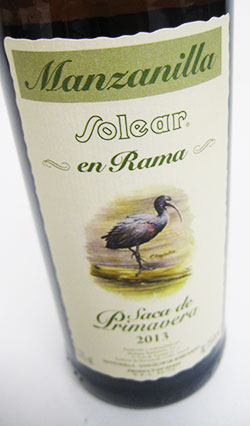Spring, From the Cask
Barbadillo Manzanilla En Rama
Saca de Primavera
Today, we complete Barbadillo's En Rama series. For me, we've saved the best for last.
Barbadillo's en Rama series are without a doubt some of the most loved sherries that we offer.
The reason is simple: Barbadillo's seasonal Manzanilla en Rama bottlings are easily some of the most compelling Manzanillas that I've ever tasted.
For the quality, this is crazy.
I first tasted Barbadillo's en Rama in sherry country in 2010 and spent the next six months trying to get it into the U.S. It was the Saca de Primavera (the spring bottling) that I had tasted and that's the one I set my sights on. Sadly, there was no chance of it. Barbadillo produces only around a 1,000 half-bottles per season and the wine barely makes it out of Spain.
 |
I love every season of the en Rama series, but my favorite is the spring bottling - it has a raciness, a flor-imbued richness and minerality that I love.
Manzanillas are fino Sherries made close to the ocean, in Sanlúcar. These are the most delicate, feather-weight dry Sherries out there, the ocean atmosphere adding a bracing, sea-breeze imbued note to the citrus-almond core.
The spring bottling captures the fineness and saline minerality more vividly than any other seasonal bottling. Despite the delicacy, the mid-palate feels richly complex with almonds, citrus, and a textured minerality. Yet, for all the intensity, there is a rapier-like cut, a gracefulness, and a long and precisely detailed finish.
Barbadillo's en Rama series is based on two things: first, the seasonal changes in temperature encourage either the growth or the decline of the flor, the yeast that live on top of Manzanilla. The flor thrives in the late spring and fall and then declines in the peak of summer and winter. The growth and decline of the flor has a big influence over the wines. Broadly speaking, at the peak of flor-growth, the wines are a little more delicate and have a certain lees-y richness; during the decline the wines pick up more oxidative power.
The second factor at play is that in an effort to capture the seasonal changes with the most clarity possible, this Manzanilla is minimally filtered - en Rama means from the cask. This is quite unusual, most Sherries are aggressively filtered. When you taste filtered and unfiltered Sherries side-by-side, you notice that there's a texture, an energy and a complexity to unfiltered sherries that the filtered versions just can't match.
Barbadillo was one of the early proponents of en Rama bottlings, starting their series back in 1999. I'm not sure if they were the first to do an en Rama, but they were definitely well ahead of the curve. In the past couple years, nearly all the top bodegas have released limited en Rama bottlings.
The en Rama series is sourced from a special Manzanilla Pasada solera that boasts 8 years of average age, which is old for Manzanilla. The best barrels of the younger solera that goes into their Solear are selected and drawn from to undergo further aging, gaining depth and complexity as they go along.
This remains one of the coolest projects that I've come across. I haven't had the opportunity to try older bottles, but Peter Liem, likely the most knowledgeable Sherry person in the U.S. says they really benefit from a couple of years in bottles. In Sherry, Manzanilla & Montilla, he writes, "it ages remarkably well - in fact, it often takes two or three years to reveal its full depth and range of aroma."
As I mentioned earlier, Barbadillo's en Ramas are some of our most popular sherry offerings. The spring bottling is just a gorgeous Manzanilla and a ridiculous value. I wish there were more available, but we'll take what we can get.
To order, reply to offers@crushwineco.com or call the store at (212) 980-9463.
Joe Salamone
Wine Buyer
Crush Wine & Spirits
